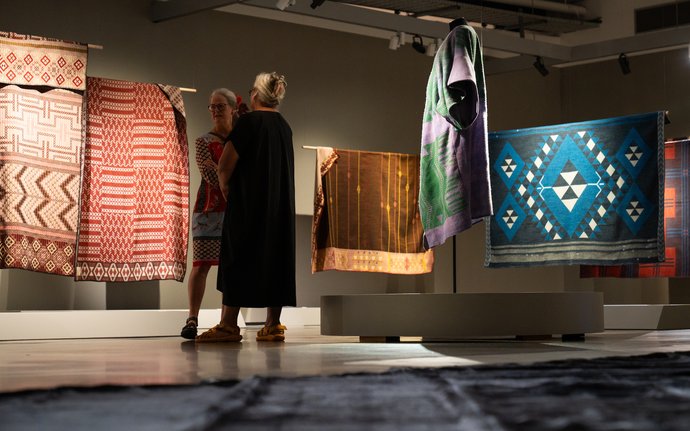Sinead Overbye reviews two Pātaka exhibitions: Maioha Kara and Paraikete Threads
2 Apr 2024, Sinead Overbye
This article first appeared in The Post, 30 March 2024

This article first appeared in The Post, 30 March 2024

Whenever I visit a whare tūpuna, I find my eyes drifting around – observing the patterns in each carved pou, following the threads in the tukutuku panels, or memorising the strokes of paint on the beams of the whare. There’s something soothing about following these patterns during wānanga – it gives you something to focus on. I’m no expert in interpreting these visual languages, but I often admire the skills it takes to create, and interpret, stories that are transmitted through visual imagery, rather than through written words.
Māori storytelling has predominantly been passed down through oral language and through our visual art forms, as mentioned above. We have a deep well of knowledges and geometries that are used in order to document and tell stories. To some, these patterns may seem like mere pictures that serve aesthetic purposes only. However, they hold deeper meanings and are often intertwined with pūrākau and other Māori histories.
Two of the current exhibitions at Pātaka Art + Museum explore Indigenous geometries in different ways.
In Good Relation is an exhibition from Maioha Kara (Ngāti Korokī Kahukura, Ngāti Tipa, Te Ātihaunui-A-Papārangi, Tūhourangi, Te Whānau a Hinetapora, Kuki Airani). It’s her first solo exhibition in a public gallery. Kara’s work is distinctive – she uses native timbers to carve geometric shapes that are based on shapes that occur in Māori and Kuki Airani (Cook Islands) artforms. The signature elements of her work are the shallow holes she excavates into her shapes. These are filled with glitter, shimmering as you move around the room.

Kara is inspired by traditional visual art forms such as whakairo, rākau, raranga, tukutuku, kōwhaiwhai and tīvaevae. These parallels are evident in works such as ‘Whakamanawa’ (2023), which seems to be inspired by the ngutu (or mouth) forms that can be seen in whakairo. The title ‘whakamanawa’ gives the work possible meanings – this word means ‘to encourage, to inspire, to reassure’. I instantly think of the tūpuna depicted in Māori carvings, and imagine that this piece is drawing them in to encourage and inspire the viewer.
The glitter on the work’s surface adds another dimension – each circle of glitter looks like an entire galaxy, evoking a sense of drawing in knowledge from other dimensions. This sense of boundlessness is neatly contained within the work itself, which is precisely carved out of rimu. The natural and spiritual worlds collide here, in a way that feels cohesive and controlled.
Kara explores our connectedness to the natural world, and acknowledges the mauri or living energy of all things. The works themselves hold their own mauri, which can be felt as you move around the gallery. Although photos of this exhibition are stunning in themselves, there is nothing better than sharing physical space with these taonga, and being able to feel the energies they emit.

Paraikete Threads is another exhibition at Pātaka that includes work from Noa Blanket Co, Jeanine Clarkin and The Mataaho Collective. The exhibition explores the deeper stories, histories and knowledge systems threaded through blankets and textiles.
Clarkin (Ngāti Hako, Ngāti Pāoa, Ngāti Ranginui, Ngāti Raukawa) explores the complex histories of blankets as a means of trade between early colonial settlers and Māori. She repurposes old wool blankets to create bold fashion items that are displayed on mannequins. They become examples of sustainable fashion, while symbolically linked to the histories of colonisation and the impacts of global trade on our lives.
Noa Blanket Co. is well-known for their beautifully woven paraikete or blankets. Paraikete Threads displays a range of their woven blankets, each accompanied by its own story. Like Kara’s work, Noa Blanket Co. is exploring Indigenous geometries and visual methods of storytelling. Each blanket has a distinctive set of patterns which all hold deeper meanings and kōrero.
One of the blankets that stands out to me is ‘Te Kāpene’, a deep blue blanket that displays large diamond shapes of blue and white. The distinctive figures of two birds can also be seen in the centre of the blanket. This work pays homage to our ancestral navigators, who were visionaries and led their people to voyage across the Pacific.
There are many patterns in these blankets that I recognise. There are others that are mysterious to me. Moving around the room, I read the descriptions of each blanket, but more importantly – as I did with Kara’s work – I take my time to feel the mauri of these works, and let my mind wander through the intricate designs, just as I do when I sit inside a wharenui and daydream about the patterns in the carved pou.
These exhibitions remind me of a different type of storytelling – one that doesn’t rely on written language, but where the images themselves can hold entire stories. Through shapes and colour, entire pūrākau can be brought forth. Māori shapes and Indigenous geometries hold hidden knowledge, that is waiting to be discovered.